
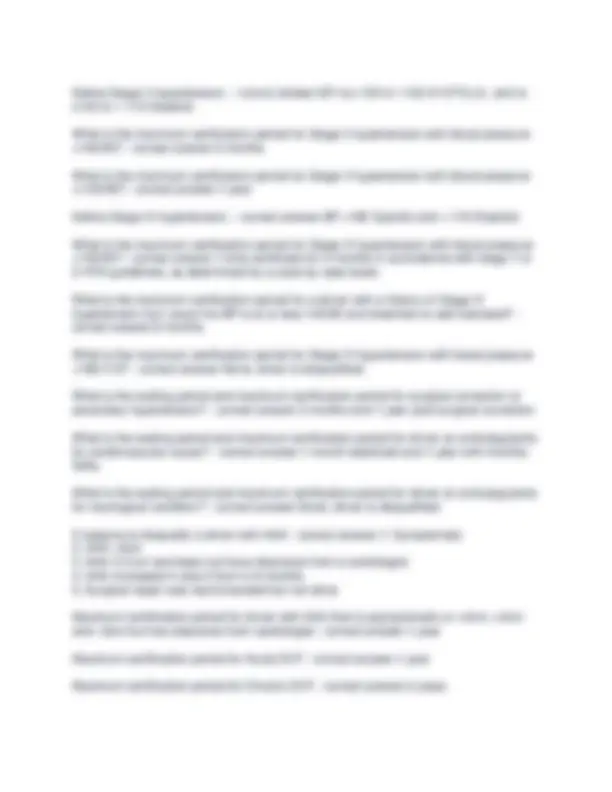
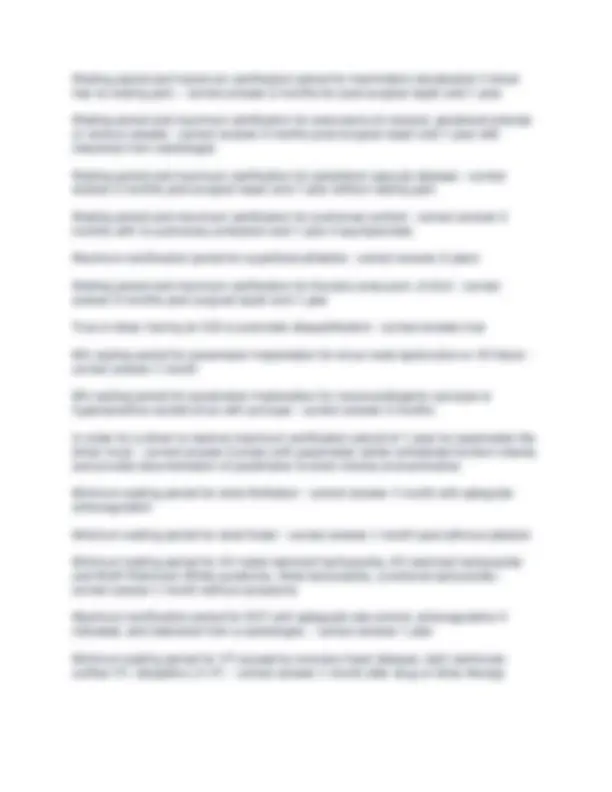
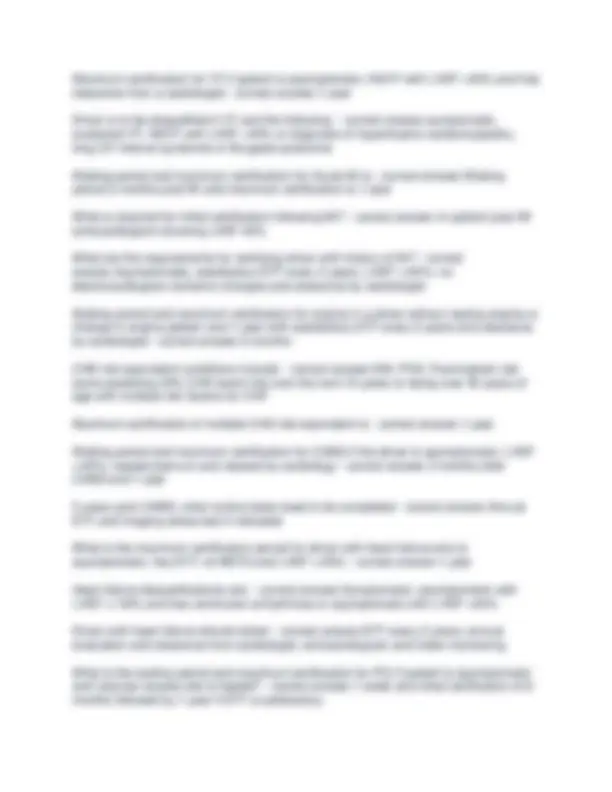
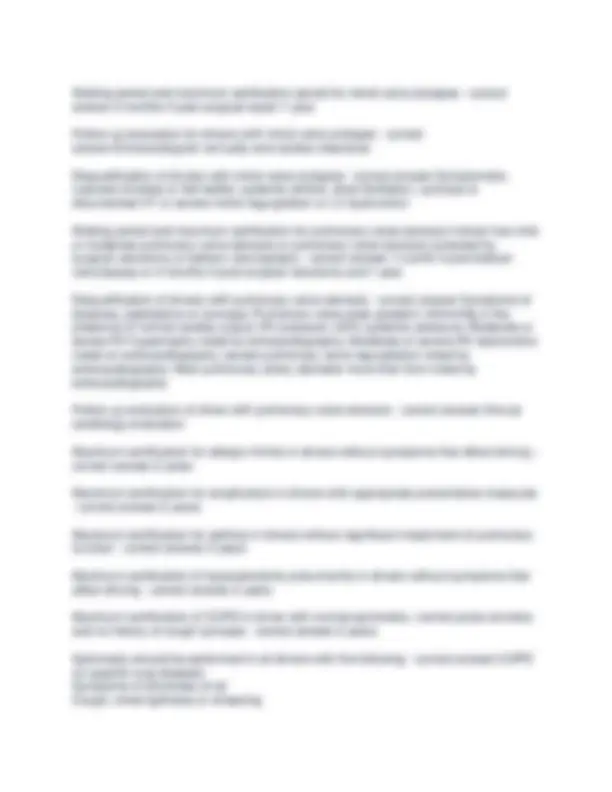
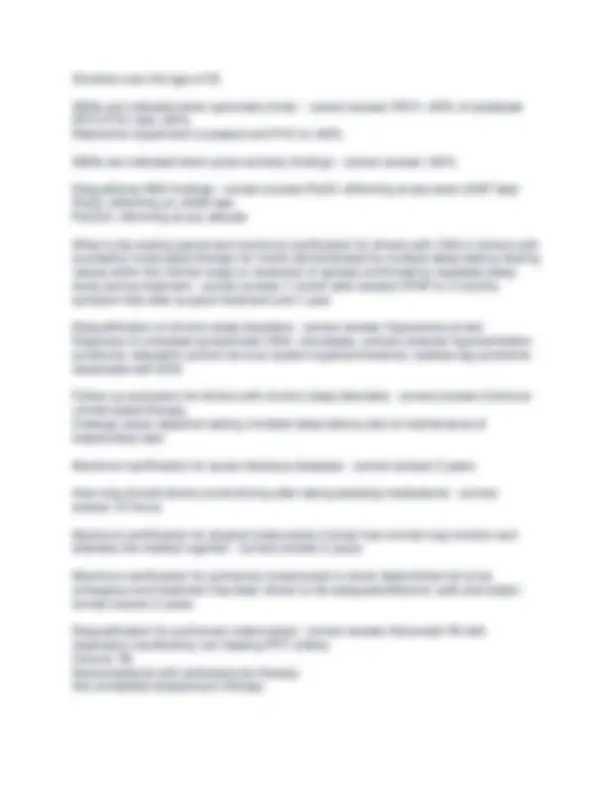
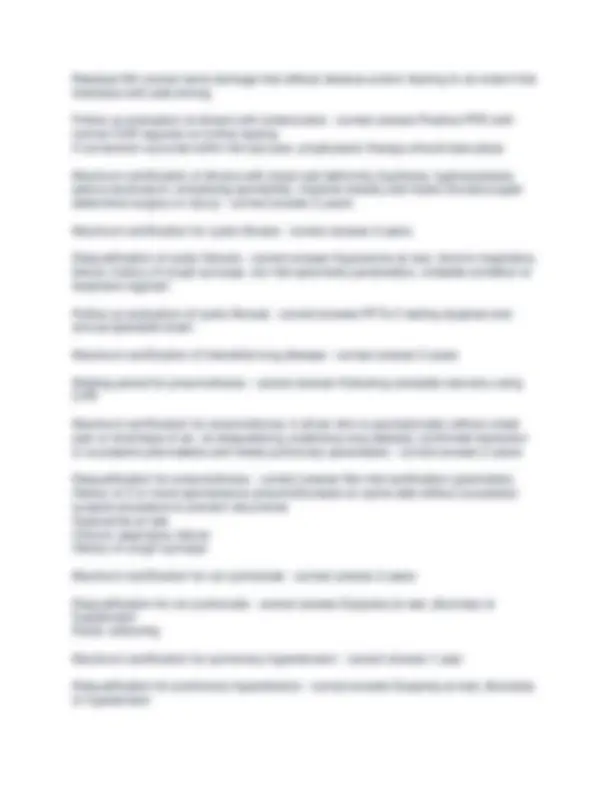
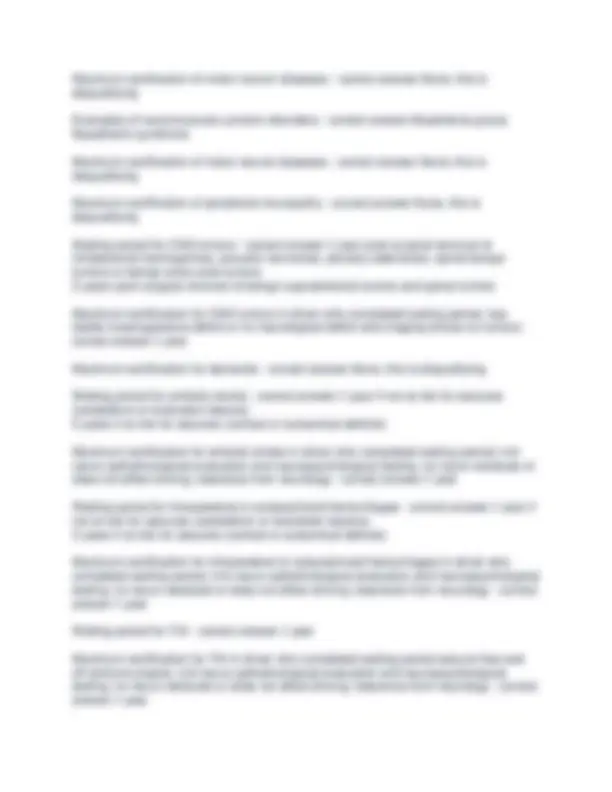
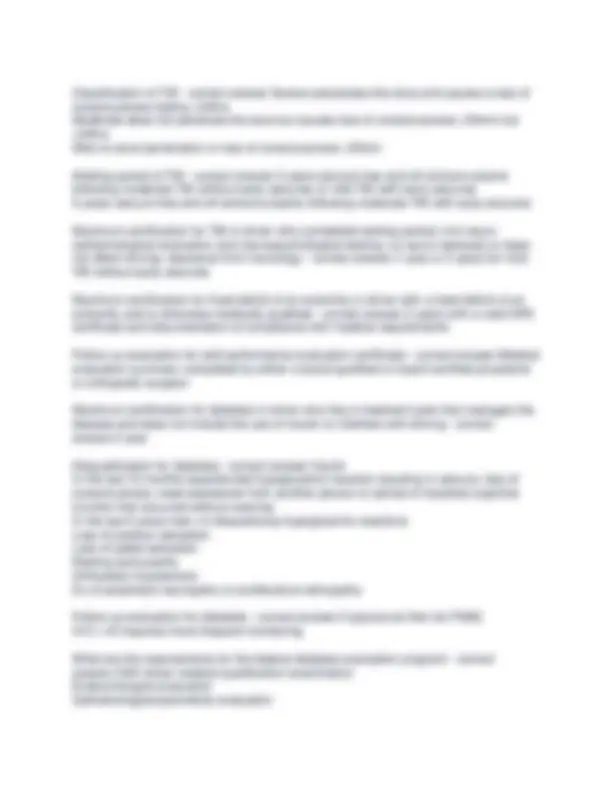
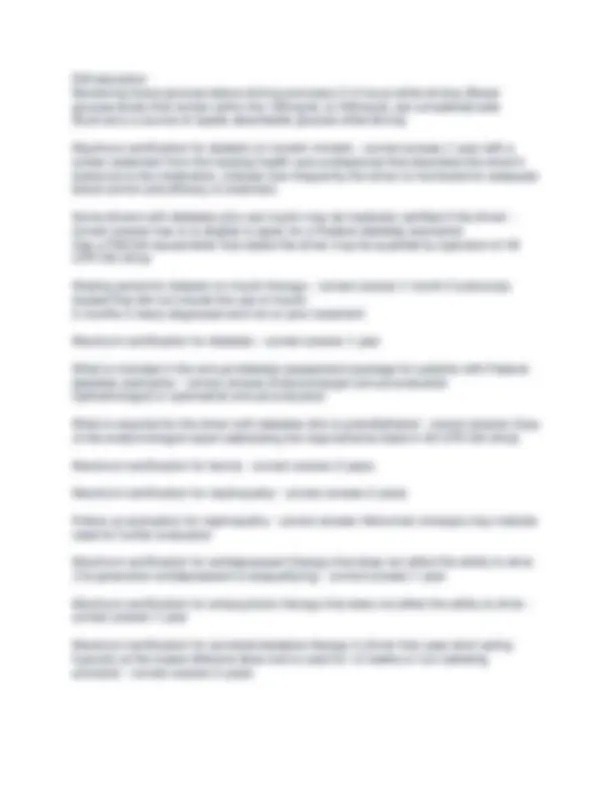
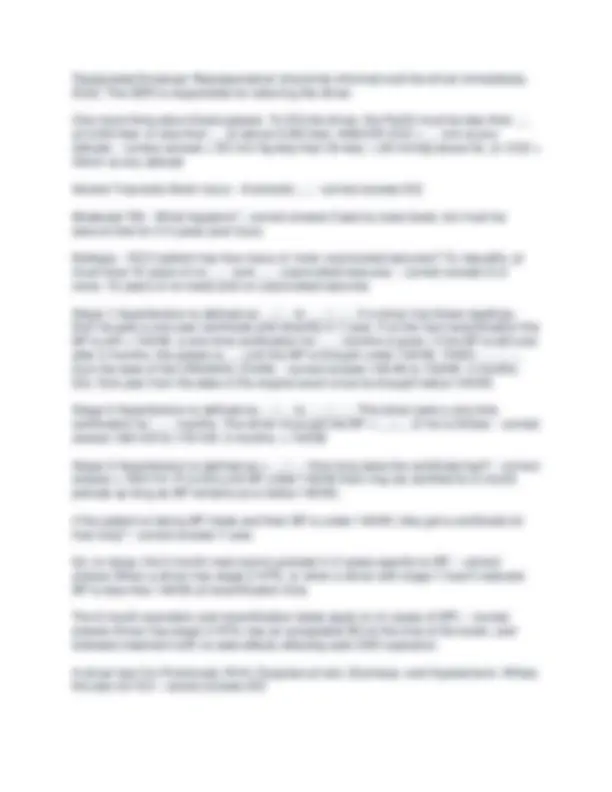

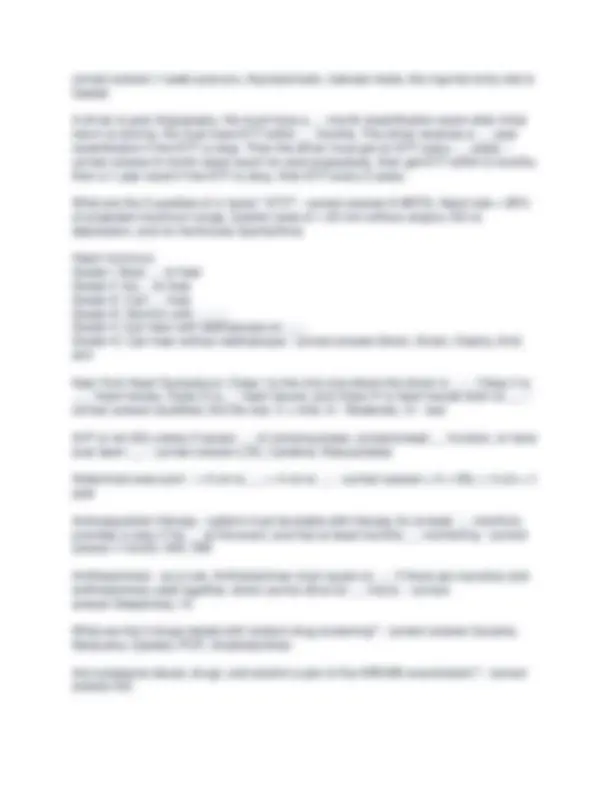
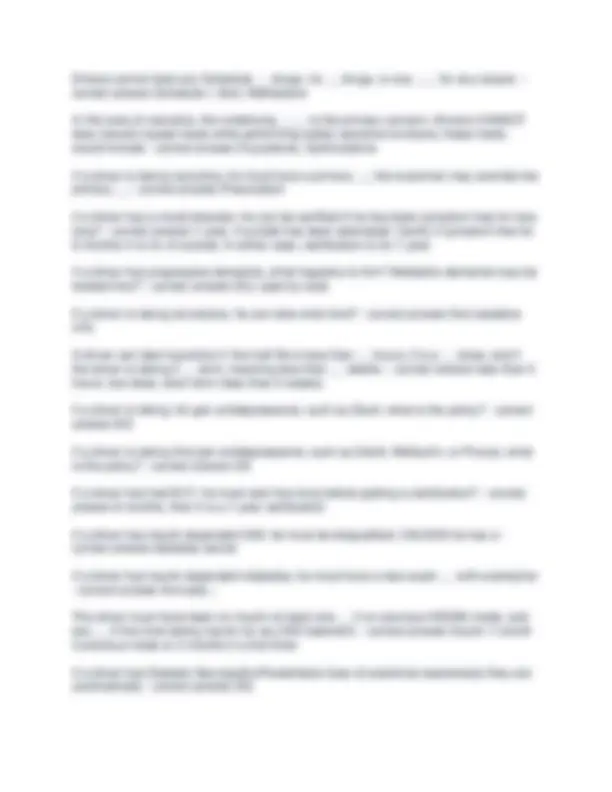
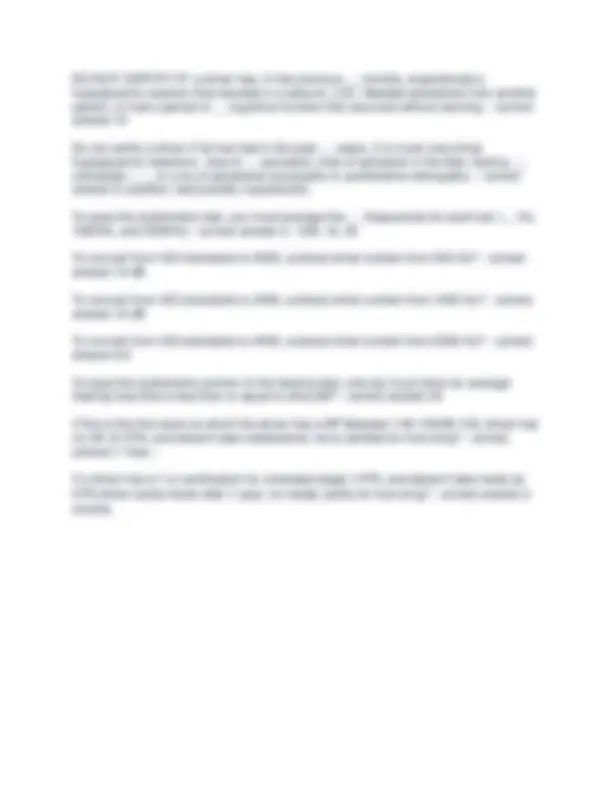


Study with the several resources on Docsity

Earn points by helping other students or get them with a premium plan


Prepare for your exams
Study with the several resources on Docsity

Earn points to download
Earn points by helping other students or get them with a premium plan
Community
Ask the community for help and clear up your study doubts
Discover the best universities in your country according to Docsity users
Free resources
Download our free guides on studying techniques, anxiety management strategies, and thesis advice from Docsity tutors
NRCME Study Exam With Complete And Detailed Solutions 2024.
Typology: Exams
1 / 22

This page cannot be seen from the preview
Don't miss anything!















vision requirements - correct answer.Distant vision 20/40 each eye and 20/40 both eyes, Peripheral vision at least 70 degrees, Ability to recognize and distinguish betwen the colors of traffic signals and devices. If the driver presents a valid vision exemption, how long can he be certified? - correct answer.1 year The driver with a vision exemption must present what 2 things before receiving the medical examiner's certificate. - correct answer.Valid vision exemption and copy of the specialist eye examination report. When applying for a vision exemption, the driver should include a copy of the Medical Examination Report form and the medical examiner's certification with what marked? - correct answer.The "accompanied by" exemption checkbox and write "vision" to identify the type of exemption. If the driver is qualified by operation of 49 CFR 391.64 due to participation in the vision study program, what must the driver present to qualify for certification? - correct answer.Letter identifying the driver as a participant and copy of the specialist eye examination. How long can a driver who is qualified by operation of 49 CFR 391.64 be certified. - correct answer.1 year hearing requirements - correct answer.Whisper at not less than 5 feet in 1 ear, or average hearing loss no greater than 40 dB at 500Hz, 1000Hz, 2000 Hz in 1 ear. What is the waiting period for vertigo caused by benign positional vertigo or acute/chronic peripheral vestibulopathy? - correct answer.3 months Name 4 otic conditions that are automatic disqualification - correct answer.Meniere's, uncontrolled vertigo, labyrinthine fistula, nonfunctioning labyrinth
Apnea-hypopnea index of [blank] or more episodes per hour is diagnostic of OSA - correct answer. 3 requirements for a passing ETT - correct answer.1. increased SBP of at least 20 without angina
Regulation that describes the responsibilities of the medical examiner. - correct answer.49 CFR 391. Regulation that describes the process for conflict resolution when there is a disagreement between the primary care provider for the driver and the medical examiner for the motor carrier concerning driving qualifications. - correct answer. CFR 391. Regulation that describes the Skill Performance Evaluation (SPE) Certification Program.
Waiting period and maximum certification period for intermittent claudication if driver has no resting pain. - correct answer.3 months for post-surgical repair and 1 year Waiting period and maximum certification for aneurysms of visceral, peripheral arteries or venous vessels - correct answer.3 months post-surgical repair and 1 year with clearance from cardiologist Waiting period and maximum certification for peripheral vascular disease - correct answer.3 months post-surgical repair and 1 year without resting pain Waiting period and maximum certification for pulmonary emboli - correct answer. months with no pulmonary embolism and 1 year if asymptomatic Maximum certification period for superficial phlebitis - correct answer.2 years Waiting period and maximum certification for thoracic aneurysm <3.5cm - correct answer.3 months post surgical repair and 1 year True or false: having an ICD is automatic disqualification - correct answer.true Min waiting period for pacemaker implantation for sinus node dysfunction or AV block - correct answer.1 month Min waiting period for pacemaker implantation for neurocardiogenic syncope or hypersensitive carotid sinus with syncope - correct answer.3 months In order for a driver to receive maximum certification period of 1 year for pacemaker the driver must: - correct answer.Comply with pacemaker center scheduled function checks and provide documentation of pacemaker function checks at examination. Minimum waiting period for atrial fibrillation - correct answer.1 month with adequate anticoagulation Minimum waiting period for atrial flutter - correct answer.1 month post-isthmus ablation Minimum waiting period for AV nodal reentrant tachycardia, AV reentrant tachycardia and Wolff-Parkinson-White syndrome, Atrial tachycardia, Junctional tachycardia - correct answer.1 month without symptoms Maximum certification period for SVT with adequate rate control, anticoagulation if indicated, and clearance from a cardiologist. - correct answer.1 year Minimum waiting period for VT caused by coronary heart disease, right ventricular outflow VT, Idiopathic LV VT. - correct answer.1 month after drug or other therapy
Maximum certification for VT if patient is asymptomatic, NSVT with LVEF >40% and has clearance from a cardiologist - correct answer.1 year Driver is to be disqualified if VT and the following: - correct answer.symptomatic, sustained VT, NSVT with LVEF <40% or diagnosis of hypertrophic cardiomyopathy, long QT interval syndrome or Brugada syndrome Waiting period and maximum certification for Acute MI is - correct answer.Waiting period 2 months post MI and maximum certification is 1 year What is required for initial certification following MI? - correct answer.In-patient post-MI echocardiogram showing LVEF 40% What are the requirements for certifying driver with history of MI? - correct answer.Asymptomatic, satisfactory ETT every 2 years, LVEF >/40%, no electrocardiogram ischemic changes and clearance by cardiologist Waiting period and maximum certification for angina in a driver without resting angina or change in angina pattern and 1 year with satisfactory ETT every 2 years and clearance by cardiologist - correct answer.3 months CHD risk-equivalent conditions include: - correct answer.DM, PVD, Framingham risk score predicting 20% CHD event risk over the next 10 years or being over 45 years of age with multiple risk factors for CHF Maximum certification of multiple CHD risk-equivalent is - correct answer.1 year Waiting period and maximum certification for CABG if the driver is asymptomatic, LVEF
/40%, healed sternum and cleared by cardiology - correct answer.3 months after CABG and 1 year 5 years post-CABG, what routine tests need to be completed - correct answer.Annual ETT and imaging stress test if indicated What is the maximum certification period for driver with heart failure who is asymptomatic, has ETT >6 METS and LVEF >/40% - correct answer.1 year Heart failure disqualifications are: - correct answer.Symptomatic, asymptomatic with LVEF </ 50% and has ventricular arrhythmias or asymptomatic with LVEF <40% Driver with heart failure should obtain - correct answer.ETT every 2 years, annual evaluation and clearance from cardiologist, echocardiogram and holter monitoring What is the waiting period and maximum certification for PCI if patient is asymptomatic and vascular access site is healed? - correct answer.1 week and initial certification of 6 months followed by 1 year if ETT is satisfactory
What disqualifies a driver with severe aortic regurgitation - correct answer.Symptomatic, unable to achieve workload > 6MET on Bruce protocol, LVEF <50%, LVEDD >70mm or LVES >55mm Follow up evaluation for drivers with severe aortic regurgitation - correct answer.Echocardiogram every 6 to 12 months if LVEDD <60mm or LVESD <50mm or every 4-6 months if LVEDD =60mm or LVESD =50mm Waiting period and maximum certification of aortic stenosis in driver with mild aortic stenosis and is asymptomatic, moderate aortic stenosis that is asymptomatic or severe aortic stenosis that has been surgically repaired - correct answer.3 months post-surgical repair and 1 year What disqualifies a driver with aortic stenosis - correct answer.If moderate aortic stenosis and angina, heart failure, atrial fibrillation, LV dysfunction with EF<50% or thromboembolism. If severe aortic stenosis regardless of symptoms. Follow up evaluation for drivers with aortic stenosis - correct answer.Echocardiogram every 5 years if mild aortic stenosis and every 1 to 2 years if moderate aortic stenosis Follow up evaluation for drivers following aortic valve repair - correct answer.Two- dimensional echocardiogram with Doppler prior to discharge and follow up based on aortic regurgitation severity Waiting period and maximum certification for mitral regurgitation if driver has mild or moderate mitral regurgitation if asymptomatic, normal LF size and function and normal pulmonary artery pressure; severe mitral regurgitation that is asymptomatic; or surgical mitral valve repair, is asymptomatic and has cardiac clearance - correct answer. months if post-surgical commissurotomy and 1 year Disqualification for mitral regurgitation - correct answer.Symptoms, less than 6 METs on Bruce protocol, ruptured chordae or flail leaflet, atrial fibrillation, LV dysfunction, thromboembolism and pulmonary hypertension Follow up evaluation for drivers with mitral regurgitation - correct answer.Annual echocardiogram if moderate mitral regurgitation. ETT and echocardiogram every 6 to 12 months if severe mitral regurgitation. Waiting periods and maximum certification period for mitral stenosis in driver with mild mitral stenosis that is asymptomatic, moderate stenosis that is asymptomatic, or severe mitral stenosis and cardiac clearance - correct answer.4 weeks if post-percutaneous balloon mitral valvotomy or 3 months if post-surgical commissurotomy and 1 year Follow up evaluation for drivers with mitral stenosis - correct answer.Annual cardiac clearance with chest x-ray, electrocardiogram and two-dimensional echocardiogram with doppler
Waiting period and maximum certification period for mitral valve prolapse - correct answer.3 months if post-surgical repair 1 year Follow up evaluation for drivers with mitral valve prolapse - correct answer.Echocardiogram annually and cardiac clearance Disqualification of drivers with mitral valve prolapse - correct answer.Symptomatic, ruptured chordae or flail leaflet, systemic emboli, atrial fibrillation, syncope or documented VT or severe mitral regurgitation or LV dysfunction Waiting period and maximum certification for pulmonary valve stenosis if driver has mild or moderate pulmonary valve stenosis or pulmonary valve stenosis corrected by surgical valvotomy or balloon valvuloplasty - correct answer.1 month if post-balloon valvulopasty or 3 months if post-surgical valvotomy and 1 year Disqualification of drivers with pulmonary valve stenosis - correct answer.Symptoms of dyspnea, palpitations or syncope; Pulmonary valve peak gradient >50mmHg in the presence of normal cardiac output; RV pressure >50% systemic pressure; Moderate or severe RV hypertrophy noted by echocardiography; Moderate or severe RV dysfunction noted on echocardiography; severe pulmonary valve regurgitation noted by echocardiography; Main pulmonary artery diameter more than 5cm noted by echocardiography Follow up evaluation of driver with pulmonary valve stenosis - correct answer.Annual cardiology evaluation Maximum certification for allergic rhinitis in drivers without symptoms that affect driving - correct answer.2 years Maximum certification for anaphylaxis in drivers with appropriate preventative measures
Residual 8th cranial nerve damage that affects balance and/or hearing to an extent that interferes with safe driving Follow up evaluation of drivers with tuberculosis - correct answer.Positive PPD with normal CXR requires no further testing If conversion occurred within the last year, prophylactic therapy should take place Maximum certification of drivers with chest wall deformity (kyphosis, kyphoscoliosis, pectus excavatum, ankylosing spondylitis, massive obesity and recent thoracic/upper abdominal surgery or injury) - correct answer.2 years Maximum certification for cystic fibrosis - correct answer.2 years Disqualification of cystic fibrosis - correct answer.Hypoxemia at rest, chronic respiratory failure, history of cough syncope, not met spirometry parameters, unstable condition or treatment regimen Follow up evaluation of cystic fibrosis - correct answer.PFTs if resting dyspnea and annual specialist exam Maximum certification of interstitial lung disease - correct answer.2 years Waiting period for pneumothorax - correct answer.Following complete recovery using CXR Maximum certification for pneumothorax in driver who is asymptomatic without chest pain or shortness of air, no disqualifying underlying lung disease, confirmed resolution or successful pleurodesis and meets pulmonary parameters - correct answer.2 years Disqualification for pneumothorax - correct answer.Not met certification parameters History of 2 or more spontaneous pneumothoraces on same side without successful surgical procedure to prevent recurrence Hypoxemia at rest Chronic respiratory failure History of cough syncope Maximum certification for cor pulmonale - correct answer.2 years Disqualification for cor pulmonale - correct answer.Dyspnea at rest, dizziness or hypotension PaO2 <65mmhg Maximum certification for pulmonary hypertension - correct answer.1 year Disqualification for pulmonary hypertension - correct answer.Dyspnea at rest, dizziness or hypotension
PaO2 <65mmhg Disqualifying neurological diagnoses - correct answer.Epilepsy Severe TBI AV malformation not surgically treated Dementia Parkinson's Iatrogenic parkinsonism Cerebellar ataxia Frequent or severe headaches Waiting period for seizures due to structural insult - correct answer.1 year seizure free and off anticonvulsants following mild insult without early seizures, stroke without risk for seizures, intracerebral or subarachnoid hemorrhage without risk for seizures 2 years seizure free and off anticonvulsants following moderate insult without early seizures or mild insult with early seizures 5 years seizure free and off anticonvulsants following moderate insult with early seizures, stroke with risk for seizures or intracerebral or subarachnoid hemorrhage with risk for seizures Maximum certification for seizures due to structural insult in driver who completed the minimum waiting period; nml neuro-opthalmological evaluation and neuropsychological test; neurology clearance - correct answer.1 year Maximum certification for seizures due to systemic metabolic illness if treated and low risk for recurrence - correct answer.2 years Maximum certification for childhood febrile seizures - correct answer.2 years Waiting period for epilepsy - correct answer.10 years off anticonvulsants and seizure free Maximum certifications for headaches - correct answer.2 years Waiting period for single unprovoked seizure - correct answer.5 years seizure free and off anticonvulsants Maximum certification for single unprovoked seizure if completed waiting period and has neurology clearance - correct answer.1 year Waiting period for benign positional vertigo or acute and chronic peripheral vestibulopathy - correct answer.2 months asymptomatic Maximum certification for benign positional vertigo or acute and chronic peripheral vestibulopathy - correct answer.2 years
Maximum certification of motor neuron diseases - correct answer.None, this is disqualifying Examples of neuromuscular junction disorders - correct answer.Myasthenia gravis Myasthenic syndrome Maximum certification of motor neuron diseases - correct answer.None, this is disqualifying Maximum certification of peripheral neuropathy - correct answer.None, this is disqualifying Waiting period for CNS tumors - correct answer.1 year post-surgical removal of infratentorial meningiomas, acoustic neuromas, pituitary adenomas, spinal benign tumors or benign extra-axial tumors 2 years post-surgical removal of benign supratentorial tumors and spinal tumors Maximum certification for CNS tumors in driver who completed waiting period, has stable nonprogressive deficit or no neurological deficit and imaging shows no tumors - correct answer.1 year Maximum certification for dementia - correct answer.None, this is disqualifying Waiting period for embolic stroke - correct answer.1 year if not at risk for seizures (cerebellum or brainstem lesions) 5 years if at risk for seizures (cortical or subcortical deficits) Maximum certification for embolic stroke in driver who completed waiting period; nml neuro-opthalmological evaluation and neuropsychological testing; no neuro residuals or does not affect driving; clearance from neurology - correct answer.1 year Waiting period for intracerebral or subarachnoid hemorrhages - correct answer.1 year if not at risk for seizures (cerebellum or brainstem lesions) 5 years if at risk for seizures (cortical or subcortical deficits) Maximum certification for intracerebral or subarachnoid hemorrhages in driver who completed waiting period; nml neuro-opthalmological evaluation and neuropsychological testing; no neuro residuals or does not affect driving; clearance from neurology - correct answer.1 year Waiting period for TIA - correct answer.1 year Maximum certification for TIA in driver who completed waiting period seizure free and off anticonvulsants; nml neuro-opthalmological evaluation and neuropsychological testing; no neuro residuals or does not affect driving; clearance from neurology - correct answer.1 year
Classification of TBI - correct answer.Severe-penetrates the dura and causes a loss of consciousness lasting >24hrs Moderate-does not penetrate the dura but causes loss of consciousness >30min but <24hrs Mild-no dural penetration or loss of consciousness <30min Waiting period of TBI - correct answer.2 years seizure free and off anticonvulsants following moderate TBI without early seizures or mild TBI with early seizures 5 years seizure free and off anticonvulsants following moderate TBI with early seizures Maximum certification for TBI in driver who completed waiting period; nml neuro- opthalmological evaluation and neuropsychological testing; no neuro residuals or does not affect driving; clearance from neurology - correct answer.1 year or 2 years for mild TBI without early seizures Maximum certification for fixed deficit of an extremity in driver with a fixed deficit of an extremity and is otherwise medically qualified - correct answer.2 years with a valid SPE certificate and documentation of compliance with medical requirements Follow up evaluation for skill performance evaluation certificate - correct answer.Medical evaluation summary completed by either a board qualified or board certified physiatrist or orthopedic surgeon Maximum certification for diabetes in driver who has a treatment plan that manages the disease and does not include the use of insulin or interfere with driving - correct answer.2 year Disqualification for diabetes - correct answer.Insulin In the last 12 months experienced hypoglycemic reaction resulting in seizure, loss of consciousness, need assistance from another person or period of impaired cognitive function that occurred without warning In the last 5 years had >/2 disqualifying hypoglycemic reactions Loss of position sensation Loss of pedal sensation Resting tachycardia Orthostatic hypotension Dx of peripheral neuropathy or proliferative retinopathy Follow up evaluation for diabetes - correct answer.If glycosuria then do FSBS A1C >10 requires more frequent monitoring What are the requirements for the federal diabetes exemption program - correct answer.CMV driver medical qualification examination Endocrinologist evaluation Opthalmologist/optometrist evaluation
Disqualification for anxiolytic/sedative therapy - correct answer.Use of a sedating anxiolytic Maximum certification for CNS stimulant therapy in driver with Adult ADHD - correct answer.1 year Evaluation for CNS stimulant therapy - correct answer.Evaluation from the treating provider confirming the diagnosis of Adult ADHD Comprehensive evaluation from appropriate mental health professional Waiting period for ECT - correct answer.6 months symptom free following a coarse of ECT Maximum certification for ECT in driver who completes waiting period, has comprehensive evaluation from an appopriate mental health professional, is not undergoing maintenace ECT and tolerates treatment without disqualifying side effects - correct answer.1 year Maximum certification for lithium therapy in driver whi is asymptomtic, lithium levels are maintained in the therapeutic range and ha sno impairment that interferes with safe driving - correct answer.1 year Disqualifications for ADHD - correct answer.Active psychosis Prominent negative symptoms: compromised judgment, attentional difficulties, suicidal behavior or ideation, personality disorder that is repeatedly manifested by overt, inappropriate acts Waiting period for bipolar disorder or major depression - correct answer.6 months symptom free following a nonpsychotic major depression unaccompanied by suicidal behavior 1 year symtpom free following a severe depressive episode, suicide attempt or manic episode Maximum certification for bipolar disorder, major depression or personality disorder in driver who completes appropriate waiting period, complies with treatment program, tolerates treatment and has comprehensive evaluation from appropriate mental health professional - correct answer.1 year Disqualifications for bipolar disorder, major depression or personality disorder - correct answer.Active psychosis Prominent negative symptoms: compromised judgment, attentional difficulties, suicidal behavior or ideation, personality disorder that is repeatedly manifested by overt, inappropriate acts Follow up for major mood disorder or mental illness with psychotic features - correct answer.Every 2 years, have evaluation and clearance from mental health specialist
Driver should report manic or severe major depressive episode within how many days to his employer, medical examiner or approiate health care professional - correct answer.30 days Waiting period for schizophrenia - correct answer.6 months symptom free if a brief reactive psychosis or schizophreniform disorder 1 year symptom free if other psychotic disorder Maximum certification for schizophrenia om driver who completes appropriate waiting period, complies with treatment program, tolerates treatment and has comprehensive evaluation from appropriate mental health professional - correct answer.1 year Maximum certification for alcoholism in driver with no residual physical impairment, successfully completed counseling/treatment and no current alcohol-related disorders - correct answer.2 years Maximum certification for drug abuse in driver with no resicual physical condition and proof of successful completion of return-to-duty requirements - correct answer.2 years Disqualification for drug abuse - correct answer.Schedule I substances, amphetamines, narcotics, methadone or marijuana 4 Non-Discretionary Standards - correct answer.Epilepsy, Hearing, Vision, Insulin- Dependent DM Urine Dipstick tests for 4 things - correct answer.Blood, Specific Gravity, Sugar/Glucose, Protein SPE = Skilled Performance Evaluation. Drivers get __ years with a fixed. - correct answer. Respiratory Issues: OSA, O2 Equipment, Hypoxemia, EDS, RLS, ASthma. Which ones are DQ? - correct answer.DQ - Untreated OSA, O2 Equipment, Hypoxemia AT REST, UNTREATED "Excessive daytime sleepiness, Restless Leg Syndrome,or Obstructive Sleep Apnea" Which ones are DQ? Primary alveolar hypoventilation syndrome, Idiopathic hypersomnolence, RLS w/EDS? - correct answer.All of them How does a driver become DQ'd with Asthma? - correct answer.Severe cough, Poor Med tolerance, Frequent and Severe episodes, FVC < 65%, PaO2 < 65 mm We all know that alcohol abuse is DQ. If the examiner suspects alcohol abuse, who should be informed and what should happen to the driver? Who is responsible for referring the driver to a substance abuse professional? - correct answer.The
Unstable Angina (Pain at rest, Poor Response to Medications) - correct answer.DQ What is the scoring system for the heart, based on correctable vs. noncorrectable conditions? - correct answer.Framingham If a driver has stable angina, it must be static with the 4 E's or without meds for 1 year. What are the 4 E's? - correct answer.Emotion, Extremes in weather, Exertion, Ecstasy There are guidelines for drivers who have had an MI. They include a __ month wait, EF of > __ %, A ___ ETT, They are able to tolerate _____, and they must pass the ___ physical. - correct answer.2 month wait, EF > 40%, Exercise tolerance test normal, Tolerate Medications, and pass the CMV physical A driver with SUSTAINED V TACH and an EF of < 40% will be - correct answer.DQ The definition of non sustained Vtach is > ___ and less than __. - correct answer.> 40 and < 50. I have no idea what this means. What 4 conditions calls for an ETT? - correct answer.MI, Angioplasty, Static Angina, CABG If a patient has an ICD, what is the ruling? - correct answer.DQ, no exceptions If a driver has a pacemaker, when can they return to driving? - correct answer.One month post implant, and then do a one year routine check What is the most common form of heart failure? - correct answer.Idiopathic Dilated Cardiomyopathy There are 6 criteria for a driver to return to work post CABG. 1. Driver can return to work __ months post procedure. 2. The driver must be ______. 3. The driver must have an EF of > __ %. 4. The certification period is __. 5. The driver must be able to tolerate _____. 6. The driver must have a __ year __ due to likliehood of reocclusion. Then a yearly ETT. - correct answer.3 months post procedure, Asymptomatic, EF of > 40%, certification period is yearly, tolerate medications, 5 year post CABG ETT, then yearly afterwards Afib risks include embolus or stroke. How long can the certificate be for? - correct answer.1 year if rate controlled via meds If a patient has significant pulmonary htn, what immediately happens? - correct answer.DQ A driver is post Angioplasty. The driver can return to work when: he is __ week post- procedure, __symptomatic, Is able to tolerate ____, and the __ ___ site is healed. -
correct answer.1 week post-pro, Asymptomatic, tolerate meds, the inguinal entry site is healed A driver is post Angioplasty. He must have a __ month recertification exam after initial return to driving. He must have ETT within __ months. The driver receives a __ year recertification if the ETT is okay. Then the driver must get an ETT every __ years. - correct answer.6 month recert exam for post angioplasty, then get ETT within 6 months, then a 1 year recert if the ETT is okay, then ETT every 2 years. What are the 5 qualities of a "good " ETT? - correct answer.6 METS, Heart rate > 85% of projected maximum range, systolic raise of > 20 mm without angina, NO st depression, and no Ventricular dysrhythmia Heart murmurs: Grade I: Must __ to hear Grade II: No__ to hear Grade III: Can __ hear Grade IV: Murmur with _____ Grade V: Can hear with stethoscope on ___ Grade VI: Can hear without stethoscope - correct answer.Strain, Strain, Clearly, thrill, skin New York Heart Symposium. Class I is the only one where the driver is ___. Class II is ___ heart issues, Class III is __ heart issues, and Class IV is heart issues even at __. - correct answer.Qualified, DQ the rest. II = mild, III - Moderate, IV - rest SVT is not DQ unless 3 issues: __ of consciousness, compromised __ function, or have ever been __. - correct answer.LOC, Cerebral, Resuscitated Abdominal aneurysm - > 5 cm is __, < 4 cm is __ - correct answer.> 5 = DQ, < 4 cm = 1 year Anticoagulation therapy - patient must be stable with therapy for at least __ month(s), provides a copy if his __ at the exam, and has at least monthly __ monitoring - correct answer.1 month, INR, INR Antihistamines - as a rule, Antihistamines must cause no __. If there are narcotics and antihistamines used together, driver cannot drive for __ hours. - correct answer.Sleepiness, 12 What are the 5 drugs tested with random drug screening? - correct answer.Cocaine, Marijuana, Opiates, PCP, Amphetamines Are substance abuse, drugs, and alcohol a part of the NRCME examination? - correct answer.NO